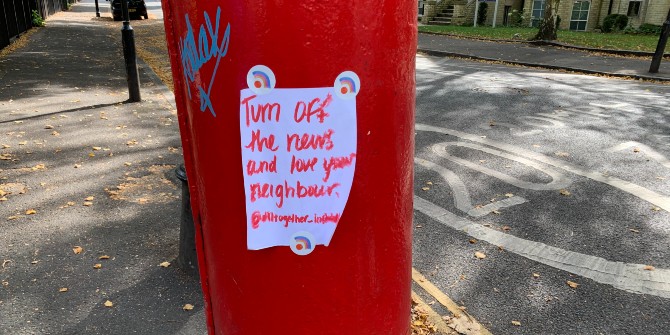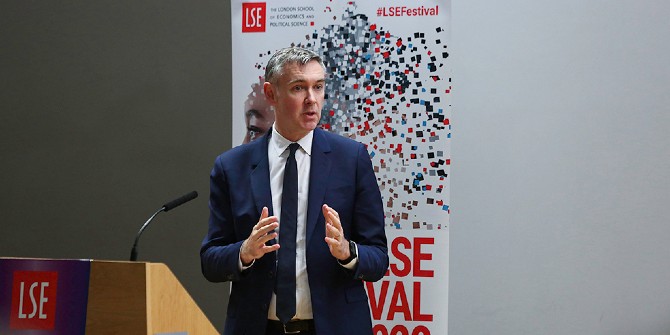Now that those at greater risk of developing a serious case of COVID-19 have been vaccinated, B.1.617.2 – the ‘Indian variant’ – is less of a danger to the UK. Paul Dolan, Christian Krekel and George Wharton (LSE) argue that the biggest concern is now people whose lives and livelihoods are harmed by lockdowns. These harms are hard to quantify, but no less real.
The Indian variant of COVID-19 may indeed turn out to be a variant of concern. But we must be clear about what constitutes legitimate causes for concern – and recognise some spurious concerns too. “Indian” and “variant” are simply words used to describe the new strain of the virus. And yet behavioural science has shown that our emotional responses to words, as well as our unconscious reactions to them, can play a huge role in determining what we do. We have seen some devastating images coming out of India recently. Naturally, our minds will make the association with them, even if we do not want to.
The “Indian variant” would have precisely the same effect on COVID-related risks if it was, more accurately, called B.1.617.2 – or even if we referred to it as “another one”. We do not say this to trivialise the variant, but to remind us all that mere labels can get in the way of us thinking and acting rationally. This is especially true at a time of heightened fear and anxiety.
Clearing our minds of spurious concerns allows us to focus on the “rational” ones. But just what are they? If all highly transmissible forms of COVID-19 are, by definition, variants of concern, the government is right to prepare us for the possibility that restrictions may be extended, nationally or locally. But transmissibility is only a cause for concern if it leads to more major illness, hospitalisations, and deaths and, at least currently, there is no evidence that this is happening in the UK. The situation could change rapidly, of course – so based on the precautionary principle, the government is right to prepare us for possible changes to the roadmap.
Throughout the pandemic, the “triple lock” of case numbers, hospitalisations, and deaths has dominated public discourse and justifications for political decisions. But the precautionary principle does not only apply to case numbers, hospitalisations – or even to deaths from COVID-19. It applies just as much to the collateral effects on health and wellbeing of policies intended to protect us from the virus. Pre-emptive actions in the form of social distancing measures carry with them not only risks, but also guaranteed harms. Loneliness evades straightforward detection, let alone quantification and so has been largely ignored whilst the media coverage emphasises virus transmission. But the fact that feelings of loneliness shorten lives is no less real.

The damage caused to people’s life expectancies and life experiences has not been adequately factored into decision-making at any stage of the pandemic, and we are concerned that it will again be downplayed in decisions about how best to respond to the new variant. Falling case numbers have an obvious political attraction and will help to allay the fears of many already scared people. But now that most people at the highest risks of severe illness from COVID-19 have been vaccinated, and at a time when vaccination rates are far greater than rates of infection, efforts at suppressing the virus must be proportionate, or risk doing more harm than good.
Now is surely the time for policy and public discourse to better reflect the changing nature of the trade-off between the risks from COVID-19 and the impact of the policy responses to suppress it. Now is surely the time to acknowledge that those at the greatest risk of harm are not those infected by COVID-19, but rather those affected by the prospects of further restrictions to their lives and livelihoods. At the very least, we should be doing more to appraise policies in ways that would enable us to determine who is most affected, in what ways, and for how long. Any further restrictions need to be considered not just in terms of the “splash” they make on case numbers, hospitalisations, and deaths, but also their ripple effects on loneliness, mental health, domestic violence, economic security, and so on.
New variants will inevitably emerge with increasing frequency until the global reservoir of infection has been reduced by a more equitable distribution of vaccines. But the emergence of new variants which are not vaccine-resistant, however transmissible they might be, should not give rise to an unremitting drumbeat of renewed fear and alarm. Vigilance is essential, but greater balance in communication of policy and its reporting will help mitigate the fear and anxiety that new variants provoke in a highly sensitised population. The way out of the pandemic for the UK remains putting jabs in people’s arms as quickly as possible and keeping us at arm’s length from one another for as little time as possible.
This post represents the views of the authors and not those of the COVID-19 blog, nor LSE.






If lockdown had the same level of side effect surveillance as vaccines it is unlikely that it would have lasted more than a week.
There was nothing precautionary about a treatment forced on a mostly uninfected population. How was it that different standards were applied to vaccines and lockdown. The medical authorities seemed very happy to go along with it.